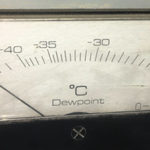
An aerospace company installed a large desiccant dryer they had as surplus from a previous installation. The unit was a heatless style with onboard dew point controller that is designed to reduce the purge flow in proportion to the flow of air going through the dryer.
The unit was oversized for the plant flow — only 30% loaded on average — with lower than rated moisture loading due to inlet temperatures that were well under the rating of 100° F. System monitors revealed, however, that even at low night time loading, and dew point control active, the dryer still consumed about 70% of its purge flow.
Various things were tried to improve the situation including changing shuttle valves, replacing the dew point controller, changing desiccant, and adjusting the purge flow, but nothing helped. Finally, the maintenance technician changed the dryer mufflers and surprisingly the desired improvement materialized, with the dryer consuming normal purge.
Maintenance records revealed the mufflers had never been changed over the life of the dryer. A check with the manufacturer’s technical support department confirmed that clogged mufflers produce a slight back pressure, making the purge process less efficient. They advise dryer purge mufflers should be changed on a regular basis to prevent problems.
The replacement costs for the mufflers were less than $1,000 but the change yielded a savings of about $6,000 per year in wasted purge energy. Plans are to address the desiccant dryers in four other plants that the maintenance department suspects have the same problem.




Leave a Reply